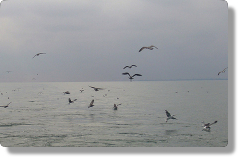
|

|


Natural climate change and variability
El Nino & La Nina
 What we know as El Nino is actually the result of two processes, one involving
the ocean and one involving the atmosphere.
What we know as El Nino is actually the result of two processes, one involving
the ocean and one involving the atmosphere.
On the ocean side of things, there is a change in the temperatures in the eastern and western Tropical Pacific. During El Nino, the western Pacific cools down and the eastern Pacific warms up. Local people have noted the periodic lack of cold, nutrient-rich deep water along the eastern Pacific Ocean for centuries. It affects the local economies that are very dependent on the fish and birds who thrive on the nutrient-rich waters. Because this temperature change often occurs near Christmas, the phenomenom was referred to as "El Nino", or "the child" in reference to the birth of Jesus.
On the atmosphere side of things is the Southern Oscillation, a see-saw pattern in the atmospheric pressure between the eastern and western Pacific. These two processes occur in tandem. During El Nino events, there is lower than usual pressure and warmer than usual ocean temperatures in the eastern Pacific. In the western Pacific, convective precipitation is limited because of cooler than usual sea surface temperatures.
The opposite phase of the oscillation is called La Nina. Because the Equatorial Pacific is a large source of heat and moisture for the rest of the world, El Nino's and La Nina's have far-reaching effects on temperature and precipitation around the world.
Next page -> El Nino / La Nina, continued
Links and resources
El Nino & La Nina
 What we know as El Nino is actually the result of two processes, one involving
the ocean and one involving the atmosphere.
What we know as El Nino is actually the result of two processes, one involving
the ocean and one involving the atmosphere.On the ocean side of things, there is a change in the temperatures in the eastern and western Tropical Pacific. During El Nino, the western Pacific cools down and the eastern Pacific warms up. Local people have noted the periodic lack of cold, nutrient-rich deep water along the eastern Pacific Ocean for centuries. It affects the local economies that are very dependent on the fish and birds who thrive on the nutrient-rich waters. Because this temperature change often occurs near Christmas, the phenomenom was referred to as "El Nino", or "the child" in reference to the birth of Jesus.
On the atmosphere side of things is the Southern Oscillation, a see-saw pattern in the atmospheric pressure between the eastern and western Pacific. These two processes occur in tandem. During El Nino events, there is lower than usual pressure and warmer than usual ocean temperatures in the eastern Pacific. In the western Pacific, convective precipitation is limited because of cooler than usual sea surface temperatures.
The opposite phase of the oscillation is called La Nina. Because the Equatorial Pacific is a large source of heat and moisture for the rest of the world, El Nino's and La Nina's have far-reaching effects on temperature and precipitation around the world.
Next page -> El Nino / La Nina, continued
Links and resources
